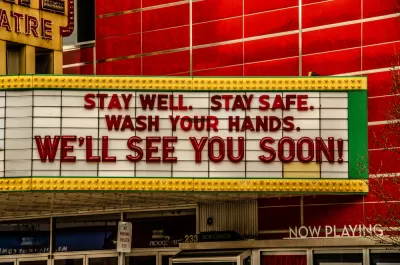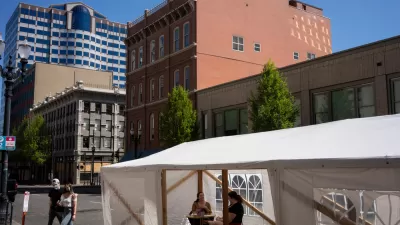Public health experts may speculate about whether the U.S. is headed for a fourth surge or moderate increase in cases, but the resurgence is well underway in Michigan where the virus was spreading the fastest. Only N.Y. has more daily infections.

Global coronavirus infections are rising rapidly, 23% in the last two weeks, according to The New York Times database on April 3.
"Steady increases in cases are concentrated in Brazil and surrounding countries, the northern US and Canada, Europe, the Middle East, and South Asia," according to the weekly newsletter posted April 2 by the Institute for Health Metrics and Evaluation (IHME) at the University of Washington. "These epidemics can be largely attributed to the spread of variants, and in the case of the US, an overly hasty re-opening may be to blame."
"A surge of new COVID-19 cases has Michigan’s rate growing faster than any other state," report Mike Wilkinson and Kelly House in late March for the non-profit news source, Bridge Michigan (source article). "In one week alone, cases have jumped 50 percent to an average of nearly 3,700 per day."
A table in the March 26 article shows Michigan with the third-highest coronavirus incidence, 38 daily new cases per 100,000 people, after New Jersey (47) and New York (42).
The coronavirus momentum in the Northeast and Upper Midwest has not ceased. On April 3, the 7-day rolling average of new cases in Michigan had surged by 71% to 65 per 100k, with New Jersey and New York recording 50 and 41 cases per 100k, respectively, according to The Washington Post's coronavirus data tracker. The U.S. average on April 3 is 20 per 100k. Daily new cases in Michigan averaged almost 6,500, second only to New York with over 8,000 cases.
Other metrics
Daily new cases is not the only metric showing that the Great Lakes State has the most serious outbreak in the country. Its infection growth rate, or R(t), is highest at 1.28, according to the coronavirus database Covid Act Now on April 2. [The outbreak grows >1 and recedes <1). Puerto Rico and Nebraska are next, with 1.27 and 1.20, respectively. The Washington Post's database's "state totals" table shows the three states/territories with the largest increase in cases in the last 7 days:
- Nebraska: 79% [25 cases per 100k]
- Puerto Rico: 54% [31 cases per 100k]
- Michigan: 39% [65 cases per 100k]
A third metric, after case incidence and infection (growth) rate used by Covid Act Now to determine risk is the test positivity rate, largely a measurement of whether enough testing is being done. Once again, Michigan leads with 12.9%, followed by Puerto Rico and New Jersey, with 11.2% and 10.4%, respectively, according to Covid Act Now on April 2.
Where's the governor?
"The stunning rise has sparked school closures statewide and renewed calls for vigilance, even as Gov. Gretchen Whitmer has said she’s not considering any new restrictions," add Wilkinson and House for Bridge's Michigan Health Watch.
But the increase comes after months during which Michigan weathered the pandemic better than most other states, with Whitmer’s administration pointing to its tough — and controversial — restrictions that limited business, schools and social gatherings.
Whitmer told a group on Thursday [March 25] that she’s not considering any new restrictions, saying this increase is “different” because health officials know more about COVID-19 and the variants.
On April 2, Wilkinson reports:
Whitmer made clear, at a mass vaccination event in Oakland County, that she has no intention of ordering new restrictions on the state’s businesses and people, as she enacted during a surge of cases in the fall. Instead, she said, residents now have more tools to avoid COVID-19: getting vaccinated and continuing to adhere to long-standing guidelines of wearing masks and keeping social distance.
Why Michigan?
Wilkinson and House offer three possible "theories" to explain Michigan's fourth surge (see the graph of new reported cases, March 2020 – April 2021).
-
Theory No. 1: Virus variants
Across the hottest hotspots in Michigan — the Thumb and northern Michigan — public health and school officials blame the more contagious B.1.1.7 variant.
What's surprising is the major role that youths play, no pun intended, in spreading the virus, as Dave Boucher and Kristen Jordan Shamus reported on March 17 in the Detroit Free Press:
School-related COVID-19 outbreaks are rising in Michigan, and many are tied to youth and high school sports, Michigan's leading epidemiologist said Wednesday.
"The largest number of outbreaks are in K-12 school settings at 162, with 54 new outbreaks reported this week," said Sarah Lyon-Callo, the director of the Bureau of Epidemiology and Population Health at the state health department.
However, she said children ages 10-19 now have the highest COVID-19 case rate in Michigan, a rate that "is increasing faster than that of other age groups."
Dr. Joneigh S. Khaldun, the state’s chief medical executive, told Julie Bosman of The New York Times on April 1 that "the most significant increase in hospitalizations in the state is in people in their 50s, a group still at risk of becoming severely ill or dying from Covid-19."
-
Theory No. 2: ‘Fertile ground’
“The variant is concerning, but it’s not driving the increase,” said Joshua Petrie, a research assistant professor in the department of epidemiology at the University of Michigan’s School of Public Health.
The theory is that Michigan's success in mitigating transmission has left many people vulnerable, lacking natural immunity, protected only if vaccinated against the novel coronavirus.
Although Michigan has had over 16,000 people die from COVID-19 since the pandemic began, it had one of the lowest overall rates of infections per 100,000, ranking 43rd among all states. [Now #42].
-
Theory No.3: Pandemic fatigue
“There’s a lot of schools and people (who) kind of want to feel ‘now that we have some vaccines we should be able to get back to normal’,” said Stephanie Baker, emergency preparedness coordinator for Jackson County.
Jackson has the eighth highest case incidence, 87 per 100,000 people, of the state's 83 counties, according to Covid Act Now.
Is Michigan a sign of where the nation is headed?
Tom Perkins of the Guardian explores that possibility in his March 24th article.
The state’s numbers, especially hospitalizations, are a cautionary tale that underscores the need for a speedier vaccine rollout here and nationwide, said Dr Jennifer Nuzzo, an epidemiologist at the Johns Hopkins University School of Public Health.
According to the Times' Michigan tracker, hospitalizations on April 2 averaged 2,267, a 99% increase over 14 days.
“We could very well see an increase of cases in a number of states, and we already are seeing that in Michigan, but if you address the vaccine supply bottleneck then it won’t translate into a huge surge,” she said. “At the end of the day, whether there’s a real surge will depend on vaccinations.”
That appears to be Gov. Whitmer's strategy, as well as the governors of the 15 other states that saw cases grow by more than 10% during the last week who are unwilling to impose stronger restrictions to mitigate the spread of the virus that has killed 550,000 Americans to date. IHME projected on April 1 that the death toll will increase to 609,000 by July 21.
Related in Planetizen:
-
How Widespread Is the Coronavirus in Your Metro Area? [How to use Covid Act Now database], January 19, 2021
-
Pandemic Geography: What's Wrong in Rhode Island? December 13, 2020
-
No Place to Play During the Pandemic, October 28, 2020
FULL STORY: Michigan tops U.S. in new COVID cases. Is it variants or just our turn?

Study: Maui’s Plan to Convert Vacation Rentals to Long-Term Housing Could Cause Nearly $1 Billion Economic Loss
The plan would reduce visitor accommodation by 25,% resulting in 1,900 jobs lost.

North Texas Transit Leaders Tout Benefits of TOD for Growing Region
At a summit focused on transit-oriented development, policymakers discussed how North Texas’ expanded light rail system can serve as a tool for economic growth.

Why Should We Subsidize Public Transportation?
Many public transit agencies face financial stress due to rising costs, declining fare revenue, and declining subsidies. Transit advocates must provide a strong business case for increasing public transit funding.

How Community Science Connects People, Parks, and Biodiversity
Community science engages people of all backgrounds in documenting local biodiversity, strengthening connections to nature, and contributing to global efforts like the City Nature Challenge to build a more inclusive and resilient future.

Alabama: Trump Terminates Settlements for Black Communities Harmed By Raw Sewage
Trump deemed the landmark civil rights agreement “illegal DEI and environmental justice policy.”

Dear Tesla Driver: “It’s not You, It’s Him.”
Amidst a booming bumper sticker industry, one writer offers solace to those asking, “Does this car make me look fascist?”
Urban Design for Planners 1: Software Tools
This six-course series explores essential urban design concepts using open source software and equips planners with the tools they need to participate fully in the urban design process.
Planning for Universal Design
Learn the tools for implementing Universal Design in planning regulations.
City of Santa Clarita
Ascent Environmental
Institute for Housing and Urban Development Studies (IHS)
City of Grandview
Harvard GSD Executive Education
Toledo-Lucas County Plan Commissions
Salt Lake City
NYU Wagner Graduate School of Public Service





























